headlights FIAT BARCHETTA 2003 1.G Owners Manual
[x] Cancel search | Manufacturer: FIAT, Model Year: 2003, Model line: BARCHETTA, Model: FIAT BARCHETTA 2003 1.GPages: 170, PDF Size: 3.55 MB
Page 7 of 170
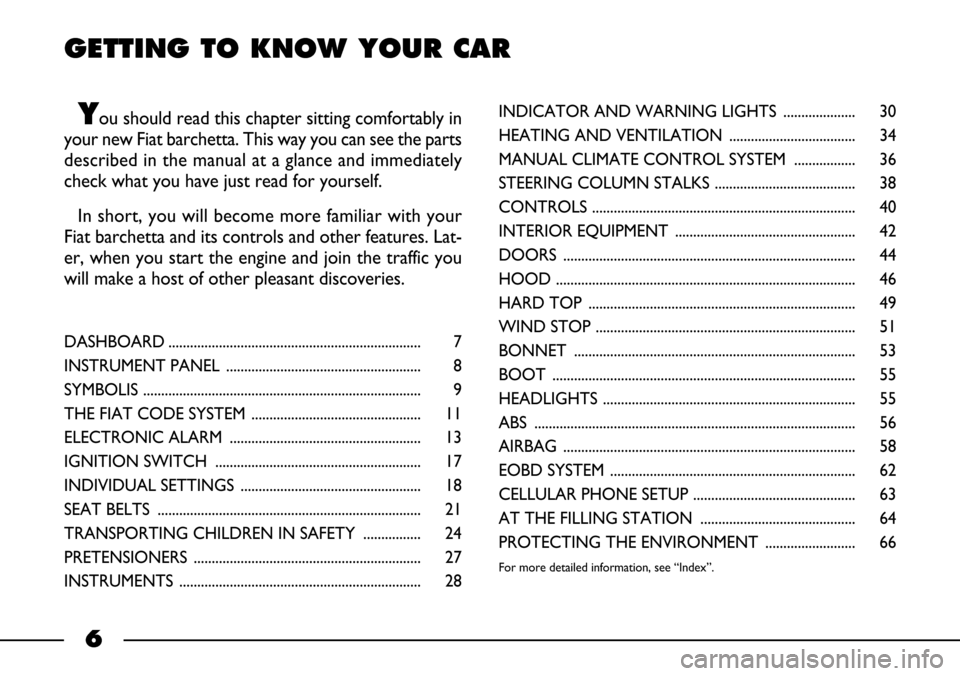
GETTING TO KNOW YOUR CAR
You should read this chapter sitting comfortably in
your new Fiat barchetta. This way you can see the parts
described in the manual at a glance and immediately
check what you have just read for yourself.
In short, you will become more familiar with your
Fiat barchetta and its controls and other features. Lat-
er, when you start the engine and join the traffic you
will make a host of other pleasant discoveries.
DASHBOARD ...................................................................... 7
INSTRUMENT PANEL ...................................................... 8
SYMBOLIS ............................................................................. 9
THE FIAT CODE SYSTEM ............................................... 11
ELECTRONIC ALARM ..................................................... 13
IGNITION SWITCH ......................................................... 17
INDIVIDUAL SETTINGS .................................................. 18
SEAT BELTS ......................................................................... 21
TRANSPORTING CHILDREN IN SAFETY ................ 24
PRETENSIONERS ............................................................... 27
INSTRUMENTS ................................................................... 28INDICATOR AND WARNING LIGHTS .................... 30
HEATING AND VENTILATION ................................... 34
MANUAL CLIMATE CONTROL SYSTEM ................. 36
STEERING COLUMN STALKS ....................................... 38
CONTROLS ......................................................................... 40
INTERIOR EQUIPMENT .................................................. 42
DOORS ................................................................................. 44
HOOD ................................................................................... 46
HARD TOP .......................................................................... 49
WIND STOP ........................................................................ 51
BONNET .............................................................................. 53
BOOT .................................................................................... 55
HEADLIGHTS ...................................................................... 55
ABS ......................................................................................... 56
AIRBAG ................................................................................. 58
EOBD SYSTEM .................................................................... 62
CELLULAR PHONE SETUP ............................................. 63
AT THE FILLING STATION ........................................... 64
PROTECTING THE ENVIRONMENT ......................... 66
For more detailed information, see “Index”.
6
Page 30 of 170
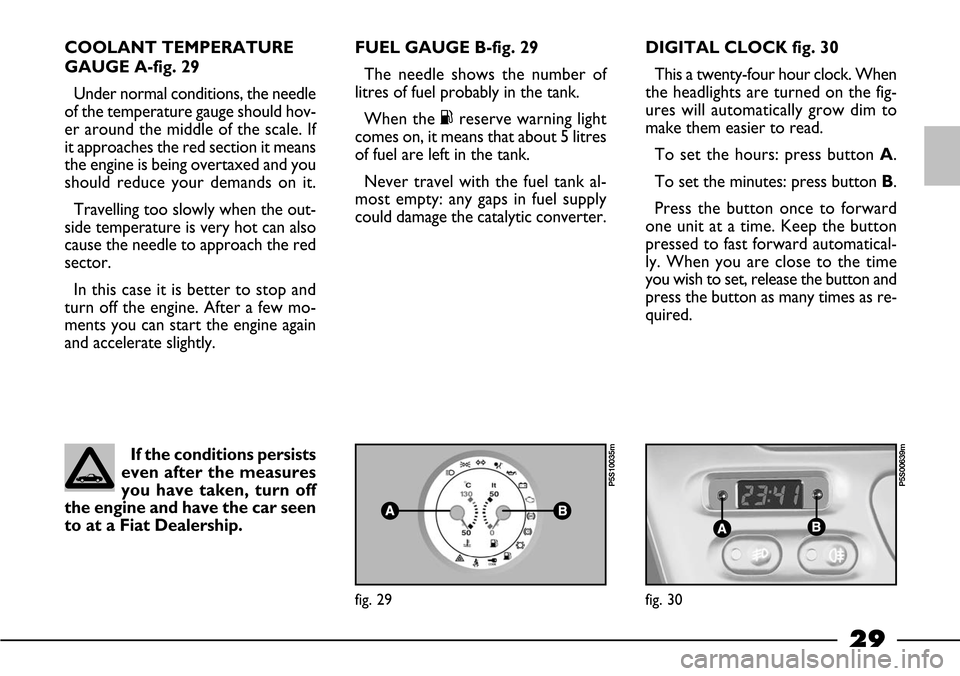
29
COOLANT TEMPERATURE
GAUGE A-fig. 29
Under normal conditions, the needle
of the temperature gauge should hov-
er around the middle of the scale. If
it approaches the red section it means
the engine is being overtaxed and you
should reduce your demands on it.
Travelling too slowly when the out-
side temperature is very hot can also
cause the needle to approach the red
sector.
In this case it is better to stop and
turn off the engine. After a few mo-
ments you can start the engine again
and accelerate slightly.FUEL GAUGE B-fig. 29
The needle shows the number of
litres of fuel probably in the tank.
When the Kreserve warning light
comes on, it means that about 5 litres
of fuel are left in the tank.
Never travel with the fuel tank al-
most empty: any gaps in fuel supply
could damage the catalytic converter.DIGITAL CLOCK fig. 30
This a twenty-four hour clock. When
the headlights are turned on the fig-
ures will automatically grow dim to
make them easier to read.
To set the hours: press button A.
To set the minutes: press button B.
Press the button once to forward
one unit at a time. Keep the button
pressed to fast forward automatical-
ly. When you are close to the time
you wish to set, release the button and
press the button as many times as re-
quired.
If the conditions persists
even after the measures
you have taken, turn off
the engine and have the car seen
to at a Fiat Dealership.
fig. 29
P5S10035m
fig. 30
P5S00639m
Page 34 of 170
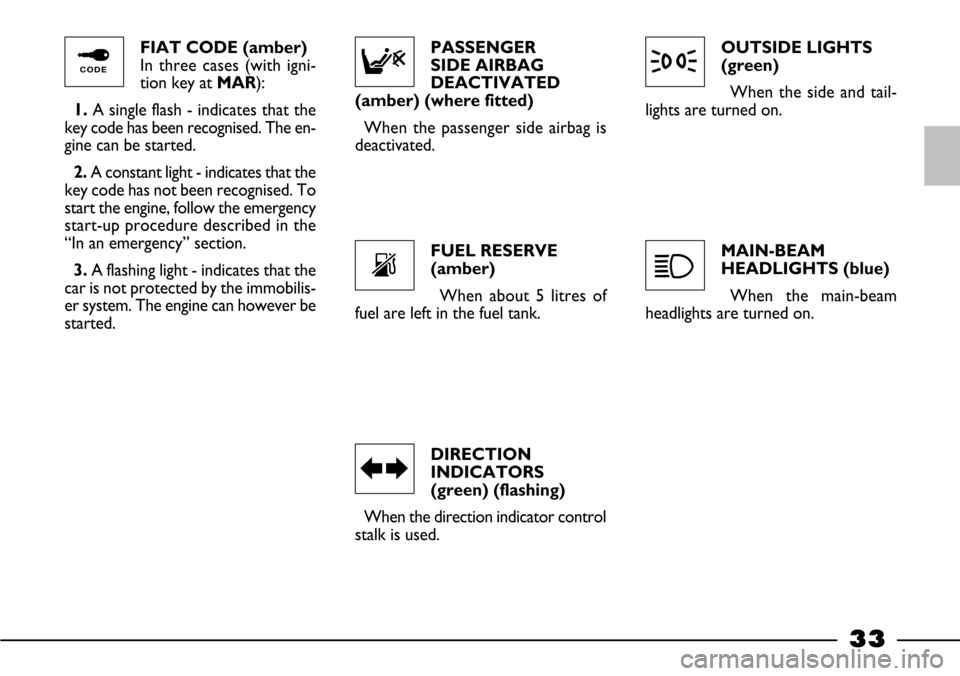
MAIN-BEAM
HEADLIGHTS (blue)
When the main-beam
headlights are turned on.OUTSIDE LIGHTS
(green)
When the side and tail-
lights are turned on.
DIRECTION
INDICATORS
(green) (flashing)
When the direction indicator control
stalk is used.FUEL RESERVE
(amber)
When about 5 litres of
fuel are left in the fuel tank.PASSENGER
SIDE AIRBAG
DEACTIVATED
(amber) (where fitted)
When the passenger side airbag is
deactivated. FIAT CODE (amber)
In three cases (with igni-
tion key at MAR):
1. A single flash - indicates that the
key code has been recognised. The en-
gine can be started.
2. A constant light - indicates that the
key code has not been recognised. To
start the engine, follow the emergency
start-up procedure described in the
“In an emergency” section.
3. A flashing light - indicates that the
car is not protected by the immobilis-
er system. The engine can however be
started.
33
°
RE
3
1
¢F
Page 39 of 170
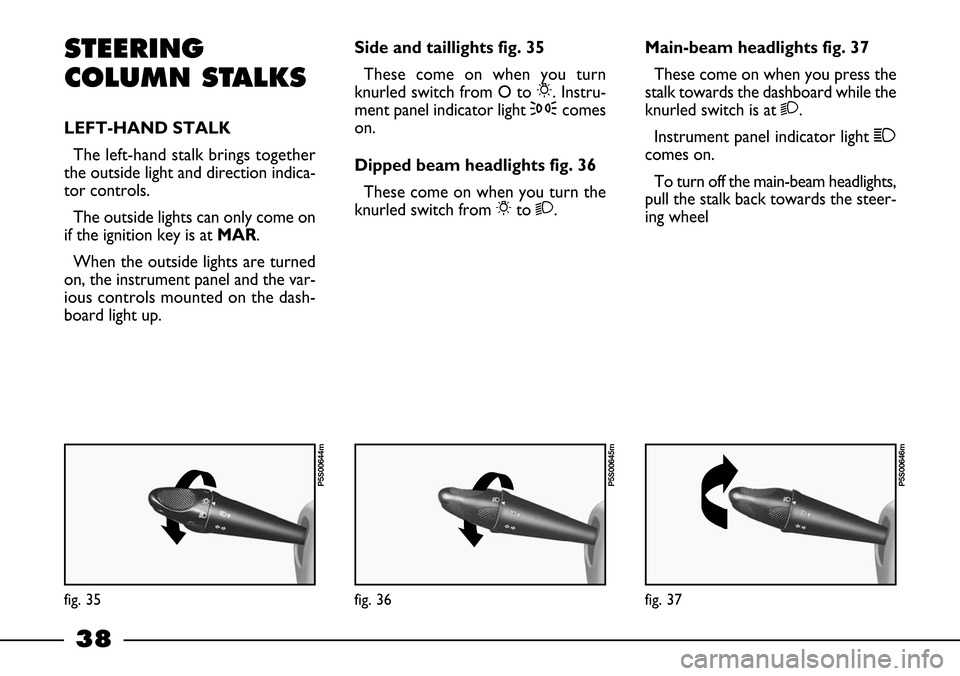
38
STEERING
COLUMN STALKS
LEFT-HAND STALK
The left-hand stalk brings together
the outside light and direction indica-
tor controls.
The outside lights can only come on
if the ignition key is at MAR.
When the outside lights are turned
on, the instrument panel and the var-
ious controls mounted on the dash-
board light up.Side and taillights fig. 35
These come on when you turn
knurled switch from O to 6. Instru-
ment panel indicator light 3comes
on.
Dipped beam headlights fig. 36
These come on when you turn the
knurled switch from 6to 2.Main-beam headlights fig. 37
These come on when you press the
stalk towards the dashboard while the
knurled switch is at 2.
Instrument panel indicator light 1
comes on.
To turn off the main-beam headlights,
pull the stalk back towards the steer-
ing wheel
fig. 35
P5S00644m
fig. 36
P5S00645m
fig. 37
P5S00646m
Page 40 of 170

39
Flashing the headlights fig. 38
To flash the headlights pull the stalk
towards the steering wheel (tempo-
rary position).Direction indicators fig. 39
Move the stalk as follows to turn on
the direction indicators:
up - for the right indicator
down - for the left indicator.
Instrument panel indicator light y
flashes.
The direction indicators turn off au-
tomatically when the car straightens
up.
If you want the indicator to flash
briefly, move the stalk up or down
without it clicking into position. When
you let it go it will return to its origi-
nal position.RIGHT-HAND STALK
The right-hand stalk brings together
all the windscreen cleaning controls.
Windscreen wiper fig. 40
This feature can only work when the
ignition key is at MAR.
0- Windscreen wiper off.
1- Flick wipe.
2- Slow continuous wipe.
3- Fast continuous wipe.
4 - Temporary continuous slow wipe
function: when you release the stalk,
it returns to position 0and automat-
ically turns off the windscreen wiper.
fig. 38
P5S00648m
fig. 40
P5S00649m
fig. 39
P5S00647m
Page 42 of 170
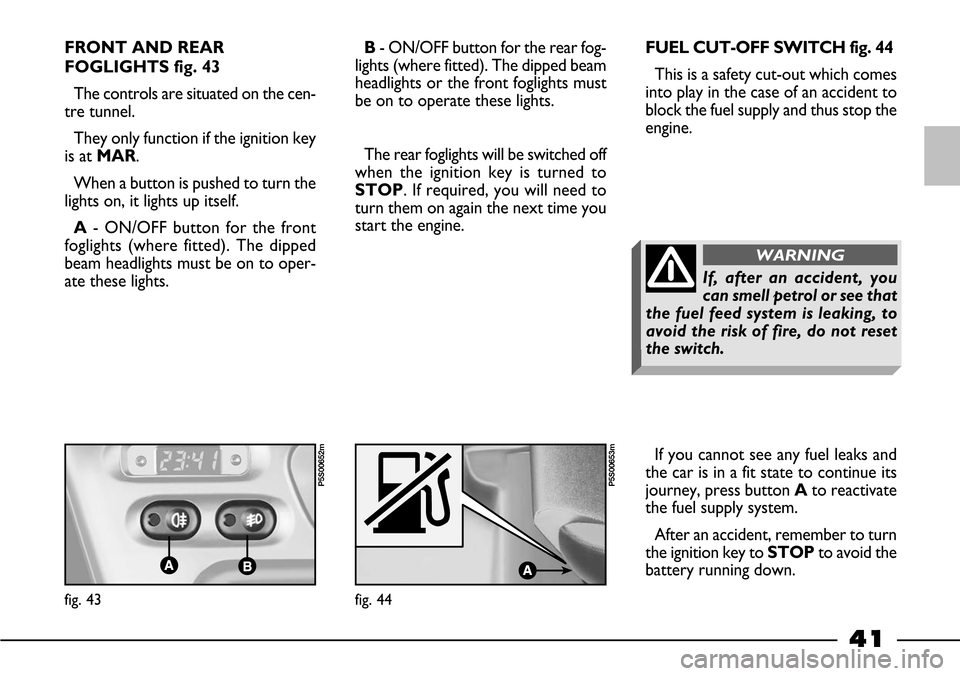
41
FRONT AND REAR
FOGLIGHTS fig. 43
The controls are situated on the cen-
tre tunnel.
They only function if the ignition key
is at MAR.
When a button is pushed to turn the
lights on, it lights up itself.
A- ON/OFF button for the front
foglights (where fitted). The dipped
beam headlights must be on to oper-
ate these lights.B- ON/OFF button for the rear fog-
lights (where fitted). The dipped beam
headlights or the front foglights must
be on to operate these lights.
The rear foglights will be switched off
when the ignition key is turned to
STOP. If required, you will need to
turn them on again the next time you
start the engine.FUEL CUT-OFF SWITCH fig. 44
This is a safety cut-out which comes
into play in the case of an accident to
block the fuel supply and thus stop the
engine.
If you cannot see any fuel leaks and
the car is in a fit state to continue its
journey, press button Ato reactivate
the fuel supply system.
After an accident, remember to turn
the ignition key toSTOPto avoid the
battery running down.
fig. 44
P5S00653m
fig. 43
P5S00652m
If, after an accident, you
can smell petrol or see that
the fuel feed system is leaking, to
avoid the risk of fire, do not reset
the switch.
WARNING
Page 56 of 170

55
BOOT
To open the boot, open the driver’s
side door, release the lock using the
ignition key and lift lever A-fig. 75in
the door frame:
1= lever unlocked
2= lever locked
To close the boot lid, use one hand
to lower it completely, then press it
with both hands at the points indicat-
ed by the arrows. Lock lever A.IMPORTANTThe boot lid must
be closed before opening or closing
the hood.
HEADLIGHTS
ADJUSTING
THE HEADLIGHT BEAMS
The correct positioning of the head-
light beams is very important for the
comfort and safety, not only of the
person driving the car but also all oth-
er road users. This is also covered by
a specific law. To ensure you and oth-
er drivers have the best visibility con-
ditions when travelling with the head-
lights on, the headlights must be set
properly.
Have the headlight positioning
checked at a Fiat Dealershipand ad-
justed if necessary.
ADJUSTING
THE FRONT FOGLIGHTS
Have the lights checked at a Fiat
Dealershipand adjusted if necessary. The addition of objects
(speakers, spoilers, etc.)
to the boot lid or to the
rear window shelf (except when
envisaged by the manufacturer)
may prevent the gas-filled struts
at the sides of the boot from
working properly.
fig. 75
P5S00669mWhen using the boot, make
sure the load you are car-
rying does not exceed the permit-
ted weight (see the “Technical
specifications” chapter).
WARNING
Page 73 of 170

72
BEFORE GETTING BEHIND
THE WHEEL
– Make sure all lights including the
headlights are working properly.
– Adjust the position of the seats,
steering wheel, driving and door mir-
rors properly for the best driving
position.
– Carefully adjust head restraints
so the back of the head and not the
nape of the neck is supported.
– Make sure that nothing (mats
etc.) gets in the way of the pedals
when they are pushed down.
– Adjust the height of the seat
belts, adapting them to your height
(see indications given in the chapter
“Getting to know your car - seat
belts”).
– Make sure that any child restraint
systems (child seats, carriers, etc.)
are properly fixed.– Stow objects in the luggage com-
partment with care to prevent them
from being thrown forwards in the
event of an accident.
– Make sure that any child restraint
systems are properly fixed. If the
child seat is installed when a passen-
ger airbag is fitted, make sure it is
facing forwards, and position the car
seat as far back as possible.
– Do not eat a heavy meal before
travelling. Light eating will help keep
your reflexes prompt. Above all, do
not have anything alcoholic to drink.
– Remember to check what is spec-
ified in the “Repeated checks and
checks before long trips” in this sec-
tion.WHEN TRAVELLING
– The first rule of safe driving is
prudence.
– Prudence also means putting
yourself into a position where you
can predict wrong or imprudent
behaviour of other drivers.
– Stick closely to the rules of the
road in the particular country where
the car is being driven and, above all,
do not exceed speed limits.
– Do not drive with your foot rest-
ing on the clutch pedal as this will
quickly wear the clutch out.
– Ensure that, besides yourself, all
the other passengers in the car have
their seat belts fastened, that chil-
dren are sitting in the appropriate
child seats and any animals are in
special compartments.
– You should be physically fit and
mentally alert before setting out on
long journeys.
Page 75 of 170
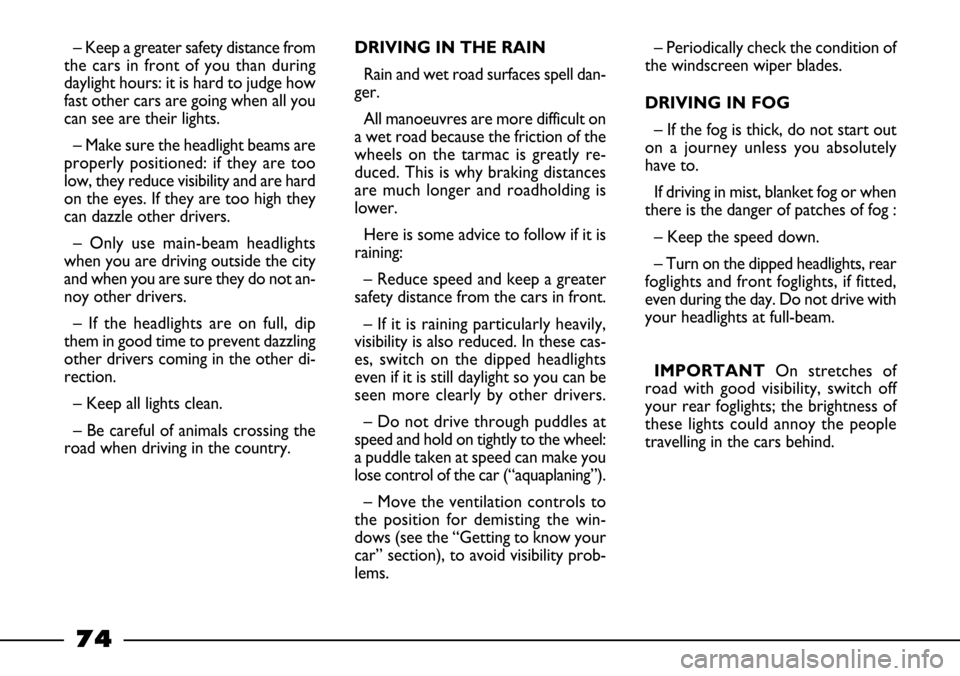
74
– Keep a greater safety distance from
the cars in front of you than during
daylight hours: it is hard to judge how
fast other cars are going when all you
can see are their lights.
– Make sure the headlight beams are
properly positioned: if they are too
low, they reduce visibility and are hard
on the eyes. If they are too high they
can dazzle other drivers.
– Only use main-beam headlights
when you are driving outside the city
and when you are sure they do not an-
noy other drivers.
– If the headlights are on full, dip
them in good time to prevent dazzling
other drivers coming in the other di-
rection.
– Keep all lights clean.
– Be careful of animals crossing the
road when driving in the country.DRIVING IN THE RAIN
Rain and wet road surfaces spell dan-
ger.
All manoeuvres are more difficult on
a wet road because the friction of the
wheels on the tarmac is greatly re-
duced. This is why braking distances
are much longer and roadholding is
lower.
Here is some advice to follow if it is
raining:
– Reduce speed and keep a greater
safety distance from the cars in front.
– If it is raining particularly heavily,
visibility is also reduced. In these cas-
es, switch on the dipped headlights
even if it is still daylight so you can be
seen more clearly by other drivers.
– Do not drive through puddles at
speed and hold on tightly to the wheel:
a puddle taken at speed can make you
lose control of the car (“aquaplaning”).
– Move the ventilation controls to
the position for demisting the win-
dows (see the “Getting to know your
car” section), to avoid visibility prob-
lems.– Periodically check the condition of
the windscreen wiper blades.
DRIVING IN FOG
– If the fog is thick, do not start out
on a journey unless you absolutely
have to.
If driving in mist, blanket fog or when
there is the danger of patches of fog :
– Keep the speed down.
– Turn on the dipped headlights, rear
foglights and front foglights, if fitted,
even during the day. Do not drive with
your headlights at full-beam.
IMPORTANTOn stretches of
road with good visibility, switch off
your rear foglights; the brightness of
these lights could annoy the people
travelling in the cars behind.
Page 76 of 170

75
– Remember that fog also means the
tarmac is wet and therefore manoeu-
vres of all kinds are more difficult and
stopping distances are longer.
– Keep a good distance from the cars
in front of you.
– As far as possible, avoid spurts of
speed or sudden deceleration.
– Do not overtake other vehicles if
you can help it.
– If you are forced to stop your car
(breakdown, limited visibility etc.) try
to stop off the road. Then turn on the
hazard lights and, if possible, the
dipped headlights. Rhythmically sound
the horn if you realise another car is
coming.
DRIVING
IN THE MOUNTAINS
– When driving downhill, use the en-
gine brake by engaging a low gear so
as not to overheat the brakes.
– Under no circumstances should
you drive downhill with the engine off
or with the car in neutral, let alone
with the ignition key out.– Drive at a moderate speed without
cutting corners.
– Remember that overtaking while
going uphill is slower and therefore re-
quires more free road. If you are be-
ing overtaken while driving uphill,
make it easier for the other vehicle
to pass.
DRIVING ON SNOW OR ICE
Here are some tips for driving in
these conditions:
– Keep your speed down.
– Use chains if the roads are covered
in snow (refer to the “Snow chains”
paragraph in this section).
– Mainly use the engine brake and
under all circumstances avoid braking
sharply.
– When braking in a car not fitted
with ABS, avoid the wheels locking by
varying the pressure you exert on the
brake pedal.
– Do not accelerate suddenly and
avoid swerving.– In the winter, even apparently dry
roads may have icy patches. Be care-
ful therefore when driving over
stretches that do not get much expo-
sure to the sun or that are lined by
trees and rocks where ice might not
have melted.
– Keep a good distance from the ve-
hicles in front.
– Do not remain for long periods in
deep snow with the engine running as
the snow could force the exhaust gas-
es into the passenger compartment.
DRIVING WITH ABS
ABS is a braking system that essen-
tially offers two advantages:
1)It prevents wheel lock-up and
consequent skidding in emergency
stops, particularly when the road does
not offer much grip.
2)It makes it possible to brake and
steer at the same time so you can
avoid unexpected obstacles and direct
the car where you want while braking.
The extent to which this can be done
will depend on the physical limits of
the tyre's sideways grip.